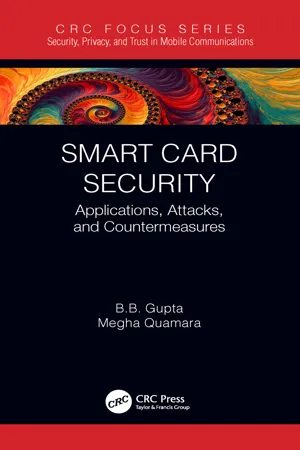
Smart Card Security
Applications, Attacks, and Countermeasures
- 118 pages
- English
- ePUB (mobile friendly)
- Available on iOS & Android
About This Book
Smart Card Security: Applications, Attacks, and Countermeasures provides an overview of smart card technology and explores different security attacks and countermeasures associated with it. It covers the origin of smart cards, types of smart cards, and how they work. It discusses security attacks associated with hardware, software, data, and users that are a part of smart card–based systems.
The book starts with an introduction to the concept of smart cards and continues with a discussion of the different types of smart cards in use today, including various aspects regarding their configuration, underlying operating system, and usage. It then discusses different hardware- and software-level security attacks in smart card–based systems and applications and the appropriate countermeasures for these security attacks. It then investigates the security attacks on confidentiality, integrity, and availability of data in smart card–based systems and applications, including unauthorized remote monitoring, communication protocol exploitation, denial of service (DoS) attacks, and so forth, and presents the possible countermeasures for these attacks.
The book continues with a focus on the security attacks against remote user authentication mechanisms in smart card–based applications and proposes a possible countermeasure for these attacks. Then it covers different communication standards for smart card–based applications and discusses the role of smart cards in various application areas as well as various open-source tools for the development and maintenance of smart card–based systems and applications. The final chapter explains the role of blockchain technology for securing smart card–based transactions and quantum cryptography for designing secure smart card–based algorithms.
Smart Card Security: Applications, Attacks, and Countermeasures provides you with a broad overview of smart card technology and its various applications.
Frequently asked questions
Information
YEAR | EVENT |
|---|---|
1968–1969 | First patent to realize the idea of plastic cards with embedded microchips or automated chip cards was filed by two German engineers, i... |
Table of contents
- Cover
- Half Title
- Title
- Copyright
- Dedication
- Contents
- List of Figures
- List of Tables
- Preface
- Acknowledgment
- About the Authors
- 1 Smart Cards: Evolution, Statistics, and Forecasts
- 2 Classification of Smart Cards and How They Work
- 3 Hardware-Level Security Attacks and Logical Threats in Smart Cards
- 4 Data Security in Smart Cards
- 5 Remote User Authentication Mechanisms in Smart Card–Based Applications
- 6 Smart Card Communication Standards, Applications, and Development Tools
- 7 Blockchain Integration and Quantum Smart Cards
- Index